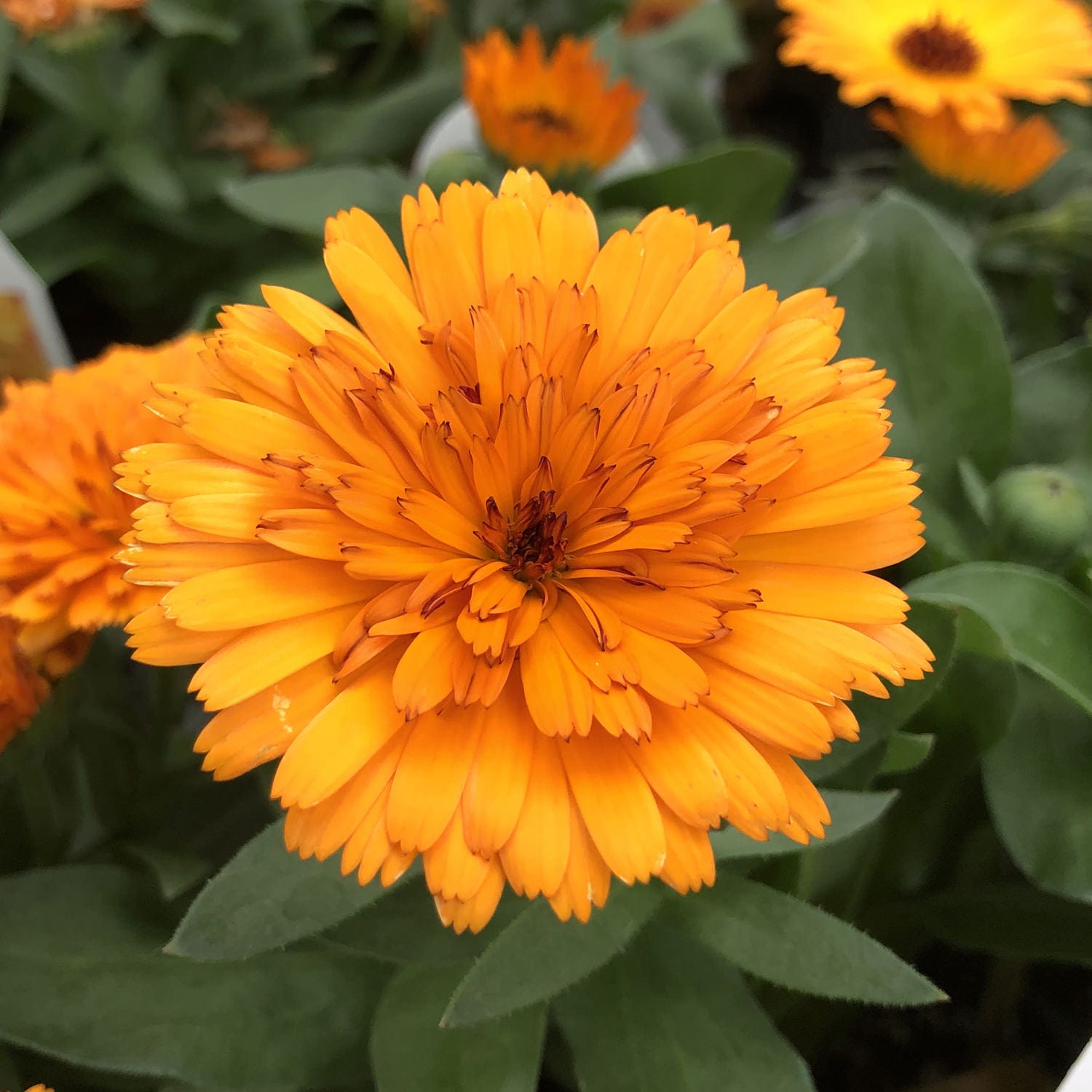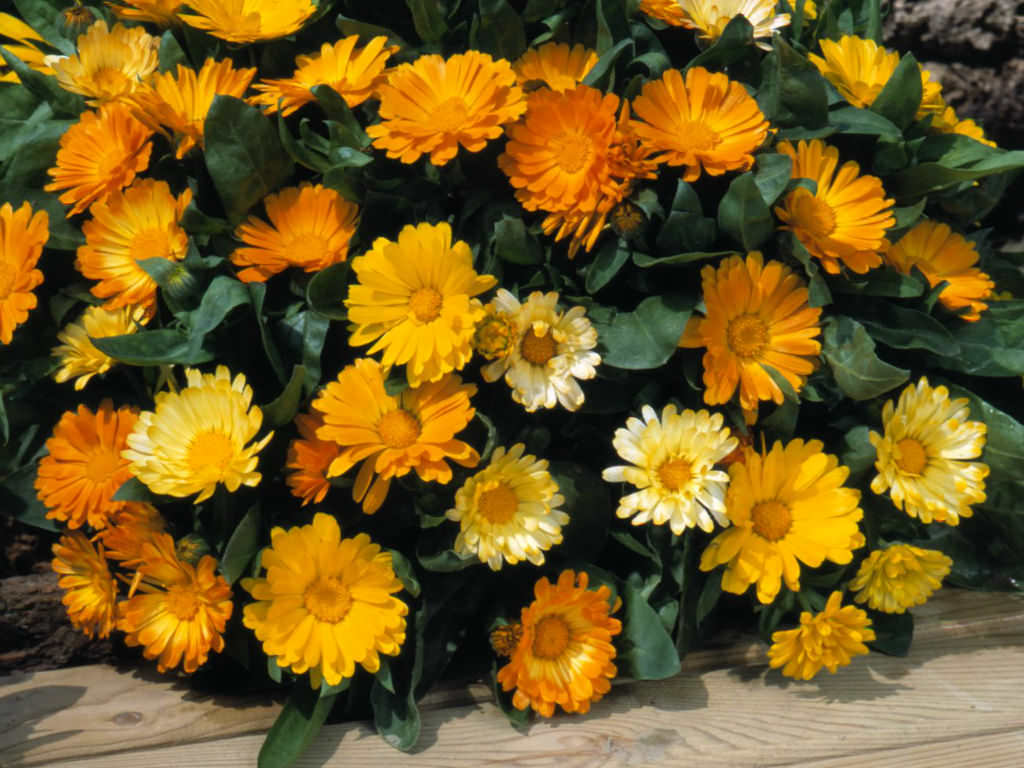What is Calendula and How Does it Grow?
Calendula, also known as pot marigold, is a flowering plant that belongs to the daisy family (Asteraceae). Its botanical name is Calendula officinalis, and it is native to the Mediterranean region. Calendula is a popular herb that has been used for centuries in traditional medicine, cooking, and as a decorative plant in gardens. It is a relatively small plant that grows to a height of 12-18 inches (30-45 cm) and has bright yellow and orange flowers that bloom from mid-spring to early fall.
Calendula grows as a tender perennial in warmer climates and as an annual in cooler climates. It prefers well-drained soil and full sun to partial shade. The plant has a moderate growth rate and can be grown from seed or by dividing established plants. Calendula is a low-maintenance plant that requires minimal care, making it an ideal choice for gardeners of all skill levels.
In terms of its growth habits, calendula is a cool-season crop, which means it thrives in the cooler temperatures of spring and fall. It can be direct-sown in the garden in early spring or started indoors 4-6 weeks before the last frost date. Calendula is also a great choice for container gardens, as it can thrive in pots and planters with good drainage.
Understanding calendula’s growth habits and requirements is essential to determining whether it is an annual or perennial plant. This knowledge will help gardeners provide the best conditions for the plant to thrive and ensure a bountiful harvest of its beautiful flowers.
Is Calendula an Annual or Perennial Plant?
Calendula is a plant that can be classified as both an annual and a perennial, depending on the climate and growing conditions. In warmer climates, calendula can be grown as a tender perennial, meaning it will come back year after year if protected from frost. However, in cooler climates, calendula is typically grown as an annual, meaning it will complete its life cycle within a year and need to be replanted every spring.
The life cycle of calendula typically begins with germination, which can occur within 1-2 weeks of sowing seeds. The seedlings will then grow and develop their first set of leaves, followed by the production of stems and flowers. Calendula flowers typically bloom from mid-spring to early fall, and the plant will continue to produce new flowers throughout the growing season.
As a perennial, calendula will typically go dormant during the winter months and regrow in the spring. However, in areas with harsh winters, calendula may need to be protected from frost or brought indoors to survive. In areas with mild winters, calendula can be grown as a perennial and will continue to produce flowers year-round.
Understanding whether calendula is an annual or perennial plant is important for gardeners who want to provide the best growing conditions for the plant. By knowing whether calendula is an annual or perennial, gardeners can plan accordingly and ensure that the plant receives the necessary care and maintenance to thrive.
Factors Affecting Calendula’s Life Cycle
Calendula’s life cycle can be influenced by several factors, including climate, soil quality, and light exposure. Climate plays a significant role in determining whether calendula is an annual or perennial plant. In areas with mild winters, calendula can be grown as a perennial, while in areas with harsh winters, it is typically grown as an annual.
Soil quality is also an essential factor in calendula’s life cycle. Calendula prefers well-drained soil that is rich in organic matter. Poor soil quality can lead to stunted growth, reduced flowering, and increased susceptibility to pests and diseases. Gardeners can improve soil quality by adding compost or well-rotted manure.
Light exposure is another critical factor that affects calendula’s life cycle. Calendula requires full sun to partial shade to produce an abundance of flowers. Inadequate light exposure can lead to weak and spindly growth, reduced flowering, and increased susceptibility to pests and diseases.
Temperature is also an important factor that affects calendula’s life cycle. Calendula prefers temperatures between 65°F and 75°F (18°C and 24°C) to grow and thrive. Extreme temperatures can lead to stunted growth, reduced flowering, and increased susceptibility to pests and diseases.
Understanding the factors that affect calendula’s life cycle is essential for gardeners who want to provide the best growing conditions for the plant. By controlling these factors, gardeners can optimize calendula’s growth and flowering patterns, ensuring a bountiful harvest of its beautiful flowers.
How to Grow Calendula as a Perennial
Growing calendula as a perennial requires careful planning and attention to detail. To start, choose a location with well-draining soil and full sun to partial shade. Calendula prefers soil that is rich in organic matter, so add compost or well-rotted manure to the soil before planting.
Plant calendula seeds in the spring or fall, about 1-2 inches deep and 6-8 inches apart. Water the soil gently but thoroughly, and keep the soil consistently moist during the first few weeks after planting. Once established, calendula is relatively drought-tolerant, but it will perform best with regular watering.
Calendula requires regular pruning to encourage bushy growth and prevent it from becoming leggy. Pinch off the tips of the stems to encourage branching, and remove any dead or damaged leaves or flowers. This will help to promote healthy growth and encourage the plant to produce more flowers.
In areas with harsh winters, calendula may need to be protected from frost. Mulch the soil around the base of the plant to insulate it from cold temperatures, and bring potted plants indoors to protect them from frost.
By following these tips and providing calendula with the right growing conditions, gardeners can enjoy its beautiful flowers for years to come. With proper care and maintenance, calendula can be a low-maintenance and rewarding perennial plant to grow.
Calendula Varieties: Annuals vs Perennials
Calendula is a versatile plant that comes in a variety of forms, including annuals and perennials. Some popular calendula varieties include ‘Pacific Beauty’, ‘Radio’, and ‘Resina’, which are all annuals. These varieties are known for their bright orange and yellow flowers and are often used in cut flower arrangements.
Perennial calendula varieties, on the other hand, include ‘Calendula officinalis’ and ‘Calendula arvensis’. These varieties are known for their ability to come back year after year and are often used in garden borders and containers.
One of the main differences between annual and perennial calendula varieties is their growth habit. Annual calendula varieties tend to grow more quickly and produce more flowers, but they often require more maintenance and may need to be replanted every year. Perennial calendula varieties, on the other hand, tend to grow more slowly and produce fewer flowers, but they are often more low-maintenance and can come back year after year.
When choosing a calendula variety, it’s essential to consider the specific growing conditions and needs of the plant. Annual calendula varieties may be a better choice for gardeners who want a quick burst of color and are willing to replant every year. Perennial calendula varieties, on the other hand, may be a better choice for gardeners who want a low-maintenance option that will come back year after year.
Regardless of whether you choose an annual or perennial calendula variety, it’s essential to provide the plant with the right growing conditions, including well-draining soil, full sun to partial shade, and regular watering.
Common Mistakes to Avoid When Growing Calendula
While calendula is a relatively easy plant to grow, there are some common mistakes to avoid in order to ensure optimal growth and flowering. One of the most common mistakes is overwatering, which can lead to root rot and other problems. Calendula prefers well-draining soil and should not be watered too frequently.
Underwatering is also a common mistake, as calendula needs consistent moisture to thrive. However, it’s essential to avoid watering the leaves, as this can lead to fungal diseases. Instead, water the soil around the base of the plant, making sure not to get the leaves wet.
Inadequate sunlight is another common mistake to avoid when growing calendula. Calendula needs full sun to partial shade to produce an abundance of flowers, so make sure to plant it in a location that receives at least 4-6 hours of direct sunlight per day.
Failure to deadhead is also a common mistake, as this can lead to a decrease in flowering. Deadheading involves removing the spent flowers to encourage the plant to produce more blooms. Simply snip off the spent flowers with scissors or pinch them off with your fingers.
Finally, not providing enough space for the plant to grow is another common mistake. Calendula can grow quite large, so make sure to provide enough space for it to spread out. A general rule of thumb is to plant calendula at least 12-18 inches apart.
By avoiding these common mistakes, you can ensure that your calendula plant thrives and produces an abundance of beautiful flowers.
Calendula Care and Maintenance
Calendula is a relatively low-maintenance plant, but it still requires some care and attention to thrive. One of the most important things to consider is fertilization. Calendula benefits from regular fertilization, especially during the growing season. Use a balanced fertilizer that is high in phosphorus to promote healthy growth and flowering.
Deadheading is another important aspect of calendula care. Remove spent flowers regularly to encourage the plant to produce more blooms. Simply snip off the spent flowers with scissors or pinch them off with your fingers.
Pest control is also important when growing calendula. Keep an eye out for pests like aphids, whiteflies, and spider mites, and treat the plant with insecticidal soap or neem oil if necessary.
Calendula is also susceptible to diseases like powdery mildew and root rot. To prevent these diseases, make sure to provide good air circulation and avoid overwatering. If you do notice any signs of disease, treat the plant with a fungicide and remove any infected leaves or stems.
Finally, calendula can be propagated through division or seed. Divide established plants in the spring or fall, and sow seeds in the spring or summer. This will help to ensure a continuous supply of calendula plants and allow you to share them with friends and family.
By following these care and maintenance tips, you can help to ensure that your calendula plant thrives and produces an abundance of beautiful flowers.
Conclusion: Unlocking Calendula’s Full Potential
In conclusion, understanding calendula’s life cycle is essential to unlocking its full potential as a beautiful and versatile flowering plant. By understanding whether calendula is an annual or perennial plant, gardeners can provide the best growing conditions and care for the plant to thrive.
Calendula’s life cycle is influenced by various factors, including climate, soil quality, and light exposure. By understanding these factors, gardeners can optimize calendula’s growth and flowering patterns, ensuring a bountiful harvest of its beautiful flowers.
Whether grown as an annual or perennial, calendula is a low-maintenance plant that requires minimal care. By following the tips and advice provided in this article, gardeners can enjoy calendula’s beautiful flowers for years to come.
In addition to its beauty, calendula also has a range of uses, including in herbal medicine, cooking, and as a natural dye. By understanding calendula’s life cycle and growing conditions, gardeners can unlock its full potential and enjoy its many benefits.
By following the guidelines outlined in this article, gardeners can successfully grow calendula and enjoy its beautiful flowers, whether as an annual or perennial plant.


:max_bytes(150000):strip_icc()/growing-and-using-calendula-1402626-28-7ba3ed2ccdd648e1b22563ba67ad48e9.jpg)




